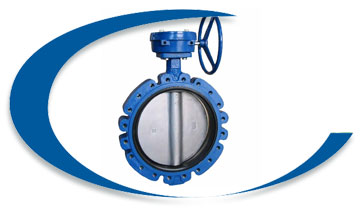Butterfly Valve

A Butterfly valve is a quarter-turn rotational motion valve, that is used to stop, regulate, and start flow. Butterfly valves are easy and fast to open. A 90° rotation of the handle provides a complete closure or opening of the valve. Large Butterfly valves are usually equipped with a so-called gearbox, where the handwheel by gears is connected to the stem. This simplifies the operation of the valve, but at the expense of speed.We are an ISO 9001:2008,ISO 9001-2008, ISO 14001-2004, OHSAS 18001-2007, NSIC-CRISIL, EEPC, and QA-UKAS (ISO 9001-2008), SSI Certified company that follows total Quality Management System. and have been recognized as one of the world’s leading stockists and manufacturer of quality metals for over two decades and are committed to quick responses, unsurpassed quality, competitive pricing, reliable deliveries and an exhaustive inventory.
Butterfly valve Specification
| Type | Butterfly valve |
| Standred | API, ASTM, ANSI , DIN, BS, JIS ,ISO approved |
| Material | Industrial-grade steel, carbon steel, stainless steel, alloy steel and special steel, A105, A182, F304, F316 |
| Size | DN25-1200 (1”-48”) |
| Diameter | 1”to13” |
| Order | Accept custom order |
Construction of a Butterfly valve
Stoppage of flow is accomplished by the valve disk sealing against a seat that is on the inside diameter periphery of the valve body. Many Butterfly valves have an elastomeric seat against which the disk seals. Other Butterfly valves have a seal ring arrangement that uses a clamp-ring and backing-ring on a serrated edged rubber ring. This design prevents extrusion of the O-rings.
Advantages and disadvantages of Butterfly valve
Advantages:
• Quarter turn• Open port
• Used with chemical or corrosive media
• Compact, lightweight design
• Available in large sizes
• Low pressure drop and high-pressure recovery
• High coefficient of flow
Disadvantages:
• Difficult to clean• Difficulty with slurries
• Throttling limited to low differential pressure
• Potential for cavitation and choke
• Unguided disc movement is affected by flow turbulence
Butterfly valve Components
Butterfly valves have a unique body construction and motion when compared to other types of valves.
Body Construction
Butterfly valves get their name from the shape of the body and closure elements. They have a simple design that consists of fewer parts, making repair and maintenance easy.
• Valve body Butterfly valves have bodies that fit between two pipe flanges. There are two types of valve bodies, the lug type and the wafer type.• The lug body has protruding legs that provide bolt holes matching those in the pipe flange. This style has metal inserts installed in the valve's bolt holes. The valve is installed between two flanges using a separate set of bolts for each flange. The advantage of the lug body style is it allows for dead-end service or removal of downstream piping.
• The wafer body style is installed between two flanges using bolts or nuts and studs. It does not have protruding legs. The shape is light-weight and has a lower initial and installation cost. However, some wafer body styles will not form a proper seal so care should be taken to avoid placing it between slip-on or screwed flange types. Wafer style valves are easier to replace and install.
Valve seat:
Most butterfly valves use an elastomeric seat and the disc seals against it. The seat utilizes an interference fit between the disc edge and the seat to provide shutoff. The flow is stopped when the valve disc seals against a seat on the inside diameter of the valve body. It may be bonded to the body or pressed or locked in. Other seal arrangements use a clamp-ring and backing-ring on a serrated edge rubber ring to block extrusion of the O-ring. In high-performance designs, the seal maybe provided by an interference-fit seat design of a line-energizes seat design. The seal is created by the pressure in the pipeline increasing the interference between the seat and disc edge. The seats of inexpensive valves may be molded into the body and cannot be repaired or replaced but in most precision valves the seats are repairable and replaceable.
Valve disc and stem assemblies:
Butterfly valves have separate stem and disc pieces that are fastened together by one of two methods. In the first method, the stem is secured with bolts or pins that go through the disc. The second method allows the disc to "float" and find its center in the seat by shaping the upper stem bore to fit a squared or hex-shaped stem. The second method of assembly can be used for corrosive applications because external stem fasteners are eliminated and covered discs can be used. The disc is held in position by the stem which must stand beyond the bottom of the disc to the bottom of the valve body. The seal is accomplished with an O-ring or standard stuffing box. The fluid in the system will come into contact with the seal so it is important to pick a steal durable enough for the media used in the system. Since the stem in most butterfly valves is protected from the media, the material can be selected with respect to cost and mechanical properties. However, in high performance types the stem is in contact with the media so the stem material must be compatible. The stem must also provide the required strength to seat and unseat the disc from the seat.
Packaging Of Butterfly valve
1.Hessian / PVC Cloth Bundles with PVC Box Strap or Hexagonal Bundles2.Wooden Crate
3.Wooden Box made of treated wood or Plywood sheet
4.Bundles (hexagonal)
5.Crates (steel/wooden)
6.Special Crates
Application Of Butterfly valve
1.Food Industries2.Water Industries
3.Oil & Gas Industries
4.Automotive Industries
5.Ship Building Industries
6.Petro-Chemical Industries
7.Engineering Cement Industries
8.Transport Industries-Rail and Road
9.Chemical & Pharmaceutical Industries
10.Construction Industries / Building Systems
